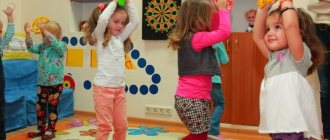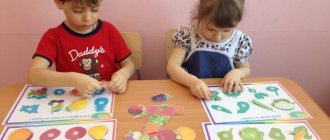A system of speech therapy work to overcome phonemic perception disorders in children with FFDD
A child’s full speech is one of the indicators of a child’s readiness to learn at school, an indispensable condition for the successful development of literacy and reading.
The development of speech in ontogenesis occurs according to certain patterns that determine the consistent and interconnected development of all aspects of the speech system (phonetic-phonemic side, vocabulary and grammatical structure).
Children with a disorder in the formation of phonetic-phonemic processes exhibit peculiarities in the sound design of speech and phonemic perception. Such children have errors in sound pronunciation and sound discrimination.
Correctional and speech therapy work on the development of phonemic perception in children of senior preschool age with phonetic-phonemic speech underdevelopment is carried out in the following sequence:
1. Perception and recognition of non-speech sounds.
2. Perception and discrimination of words that are similar in sound composition.
3. Perception and differentiation of syllables.
4. Perception and differentiation of phonemes.
5. Development of skills in elementary sound analysis.
At the first stage of speech therapy, special games and exercises are used that develop in children the ability to recognize and distinguish non-speech sounds.
To awaken interest in the sounds of the surrounding world and the sounds of speech, we offer children “The Tale of the Ear.”
- Once upon a time there was an Ear. And it went for a walk. He began to wonder what summer is? Ear walked and walked and ended up in a summer meadow. What could the Ear hear? That's right, the chirping of grasshoppers, the buzzing of bees, the rustling of grass. What if the Ear was magical and could understand the language of animals and birds, insects and plants? What would the Ear hear if it entered the forest? What would the Ear hear if it entered the group now? Let's close our eyes (we can use our palms) and try to imagine what the Ear could hear.
To develop the perception of non-speech sounds, it is effective to use games with sounding toys and objects.
For example, there are several sounding toys on the table: a tambourine, a harmonica, a bell, a rattle, etc. The speech therapist invites children to listen and remember the sound of each object. Then you just need to determine by ear, without visual support, what it sounds like. The name of each sounding object is pronounced.
Gradually, the conditions of the exercise need to be complicated: instead of sounding and musical toys, you should take jars filled with different contents (cereals, beans, sand, metal screws and nuts, pebbles). When shaken, they all make different sounds. You can take several different objects from different materials (a metal box, a glass jar, a plastic cup, a wooden box), when you tap them with a pointer you can hear different sounds.
The speech therapist calls out the sound of each object and plays it repeatedly until the children grasp the nature of the sound. Then the children are asked to determine by ear, without visual support, what it sounds like.
Also, for the purpose of training auditory perception, various phonograms are used: recording the noises of the forest, the city, the voices of birds and animals known to everyone, etc. children, listening to a phonogram and hearing the sound indicated by a speech therapist or teacher, must give a conditioned signal. For example, when you hear the mooing of a cow, show your “horns,” or the chirping of a sparrow, jump up.
It is also advisable to use exercises that are aimed at training the perception of the tempo and rhythm of words and sentences. They consist in reproducing a rhythmic pattern (rhythm) when clapping, tapping or making a sound on any instrument (tambourine, rattle, piano, accordion, etc.).
Exercises to train auditory perception were also used at the next stages of correctional work - in music classes, on walks, as physical education minutes and minutes of psychological relief in the middle of classes.
At the second stage of work on the development of phonemic perception, children train to distinguish words that are similar in their sound composition, but differ from each other in one of the differentiated sounds.
For example: a speech therapist gives the children two flags (red and green) and offers a game: if the child hears the correct name of the object shown in the picture, he should raise the green flag, if the wrong name - red. Then he shows a picture and loudly, slowly, clearly pronounces the sound combinations: baman - panam - banana - wavan - davan - bavan - vanan; tletka - kvetka - kvekta - cell - cella.
To complicate the work, children should be offered quasi-homonym words: ox - goal - floor - count; fingers - hoop; roof - rat, kidneys - barrels, duck - fishing rod, cups-checkers, etc. Using these words as an example, children are shown that when one sound is replaced, the meaning of the word changes. Children explain the meaning of each word and indicate which word contains which sound.
You can offer children the game “What sound is lost?”: listen to the rhyme, find the “wrong word” in it and replace it with a word that is similar in sound and suitable in meaning. For example: “Mom scolded the bunny - he didn’t put a nut (T-shirt) under his sweater”; “There is a lot of snow in the yard - tanks are driving along the mountain (sleds)”; “The bug didn’t finish the booth, I was reluctant, I’m tired of (the bun)”; “The lion drops his leaves (forest) on the yellowed grass”; “Mom with barrels walked along the road along the village (daughters)”; “The sea is turning blue in front of us, T-shirts are flying over the waves (seagulls)”; “They sat down in the spoon and - Come on! Along the river back and forth (boat)”; “There are no roads in the swamp, I’m on the cats - hop and hop! (bumps").
The goal of the third stage is the differentiation of syllables.
The formation of differentiation of sounds is carried out based on various analyzers: speech-auditory, speech-motor, visual. Work on differentiating mixed sounds must begin by relying on more intact visual perception, tactile and kinesthetic sensations received from the organs of articulation during the pronunciation of speech sounds, and in full - in a variety of positional conditions. Working with syllables involves the following exercises: listening comprehension and reflected reproduction.
The following types of exercises are used:
– perception and reproduction of a syllabic sequence with a change in stressed syllable (DA-DA-DA);
– perception and reproduction of syllabic combinations with a common consonant and different vowel sounds (MU-WE-MA; BUT-NA-NU);
– perception and reproduction of syllabic combinations with a common vowel and different consonant sounds (TA-KA-PA);
– perception and reproduction of syllabic combinations with consonant sounds that differ in deafness - voicedness (PA-BA-PA);
– perception and reproduction of syllable combinations with consonant sounds that differ in hardness and softness (NA-NYA);
– perception and reproduction of syllable pairs with an increase in one consonant sound (KA-TKA);
– perception and reproduction of syllabic combinations with a common combination of two consonants and different vowels (PTA-PTO-PTU-PTY);
– perception and reproduction of syllable pairs with a change in the position of consonant sounds in their combination (PTA-TPA).
These exercises can be carried out in the form of a game “Say it backwards”: the speech therapist pronounces two or three sounds, and the children must pronounce them in reverse order (pa-ba - ap-ab).
At the fourth stage, preschoolers learn to distinguish phonemes of their native language. You need to start with differentiating vowels. The setting for a given sound is reinforced by demonstrating the corresponding letter to prevent children from forgetting the original instructions. Gradually, all vowels should be in the field of auditory attention of children.
The following exercises are carried out:
1. Recognition of a vowel sound among other vowels (ua, auo, aeo, iou, etc.). If a certain vowel is named, the children give a sign. The exercise is carried out in two versions: after a choral repetition of a series of sounds and without repeated pronunciation.
Then children learn to determine the position of the sound. Having heard and repeated a word, children determine the presence of a certain vowel sound in it and name its position: initial vowel in a stressed position; initial vowel in unstressed position, vowel in the middle of the word.
2. Recognition of a consonant sound by ear in the initial position: from a series of syllables; from a word (in initial position).
Exercises can be carried out in the form of the game “Catch the Sound”. The speech therapist says: “I will name the syllables/words. Listen carefully and when you hear the sound [s], clap your hands” (son, rear, bitch, bow, scoop, beep).
Then the exercise is complicated and competition games are held: who can name the most words starting with a given letter.
3. Isolating the last consonant in a word.
Children are asked to name the last consonant of a series of words.
A more difficult task is to add the missing letter (one of the given ones: x, t, k) co-, pu-, ro-, lu-, zhu, co-.
Then the tasks are made more difficult by offering the children the game “Chain of Words.” Children need to make a chain of words - the next word begins with the last sound of the previous word (magpie - apricot - elephant - sock - cat - etc.).
Children can be divided into teams. For each answer, the team or child receives a counting stick. Whoever collects the most sticks wins.
4. Isolation of consonant sounds in phrasal speech.
To practice isolating a specific sound located in different positions, children are asked to isolate words with a given sound from a sentence. The speech therapist reads sentences to the children (Seryozha has warm mittens. This pepper is bitter. There is cold water in the well. Acacia blooms near the well) and asks: “What words with the sound [ts] did you just hear? Determine the place of this sound in the word.”
You can offer the children the game “What is the sound of the birthday boy?” The speech therapist reads a story to the children and says: “What sound do you think the birthday boy makes today? What sound is repeated most often? Name words with this sound."
For example, the following stories: “A story about a mouse: The mouse climbed into the closet. There is chocolate on the shelf in the closet. The mouse rustles the chocolate wrapper. Chocolate is delicious! A cat is walking near the closet. Hush, mouse! - [Ш]; “Tanya and Tamara at the dacha. Girls drink tea. Hot tea. The girls baked cookies for tea. The cookies are delicious” - [H]; “A story about summer: In the summer, children walked in the forest. Olya and Alina were running in the field. Lyalya and Valya were walking in the clearing. Kolya and Tolya were sawing logs” - [L'].
To complicate the task, you can offer children pictures that depict objects with the same sound often occurring. Children will identify sounds not by ear, but by idea. For example, the following pictures: skis, scissors, acorns, snowflake, giraffe, hedgehog, beetle - [f];: mole, hand, cheese, boxer, fly agaric, nettle, grass - [r]; backpack, nut, bullfinches, chair, river, mushroom - [p'].
Having named a word with a given sound, children must determine its position: “In which words did you just “catch” the sound [P]? Where is this sound located - at the beginning, in the middle or at the end of the word?
The task of the fifth stage of classes is to develop children's skills in elementary sound analysis.
The development of phonemic analysis is based on early formed skills of isolating the first and last sound, determining the place of a sound in a word (beginning, middle, end). The process of forming phonemic analysis should involve not only a complication of the forms of analysis, but also a gradual complication of speech material, an increase in the phonetic complexity of the word. The work is structured taking into account the sequence of speech material: words of two vowels (au, ua); monosyllabic words consisting of a reverse, forward, closed syllable (us, na, house, etc.); two-syllable words consisting of open syllables (mother, moon, hand, etc.); two-syllable words consisting of open and closed syllables (sofa, pocket, watermelon, cook, etc.).
Children should be taught to identify the number of syllables in a word and clap the rhythm of two- and three-syllable words. Students divide the word into syllables and sounds, using diagrams as visual support.
While working, you can use the following games:
The game “Replace the sound” - children are asked to replace one consonant sound with another to make a new word, for example: korzh - walrus, bun - booth, log - knee, salad - robe, hunger - cold.
Game “New sound” - children must name what new sound has appeared in the word, for example: bun - beam - bank - barka - burka - booth.
The game “Take out one sound” - children “take out” one sound from each word so that the remaining sounds form a new word, for example: handful - guest, regiment - floor, paint - helmet, slope - elephant, screen - crane.
In the “Add a Sound” game, children, on the contrary, must add one sound to each word to make a new word, for example: ball - scarf, paw - lamp, bite - vinegar, table - pillar, treasure - warehouse, etc.
In a situation where children find it difficult to replace on their own, you should help them and suggest the sounds to be replaced, deleted or added.
As children learn, as a result of numerous exercises on the correct perception of phonemes, on the analysis of the sound composition of speech, children find themselves well prepared for the next period of correctional and speech therapy work to overcome phonetic-phonemic underdevelopment of speech.
Bibliography:
- Alexandrova, T.V. Living sounds, or Phonetics for preschoolers: Educational and methodological manual for speech therapists and educators. / T.V.Alexandrova. - St. Petersburg: Detstvo-press, 2005. - 48 p.
- Altukhova, N.G. Learn to hear sounds. / N.G. Altukhova. - St. Petersburg: Lan, 1999. - 112 p.
- Durova, N.V. Phonemics. How to teach children to hear and pronounce sounds correctly. Toolkit. / N.V.Durova. - M.: Mosaic-Synthesis. — 112 s.
- Kolesnikova, E.V. Development of phonemic hearing in children 4-5 years old. / E.V. Kolesnikova. - M.: Yuventa, 2005. - 96 p.
- Lukinina, N.A. Teach me to hear: Development of auditory perception, attention and memory: For children 3-5 years old. / N.A. Lukinina, I.I. Nikkinen. - St. Petersburg: Paritet, 2003. - 112 p.
- Lykova, I.A. Toddler 5-7 years old. Words and syllables. Sound analysis of words. Development of phonemic hearing. / I.A.Lykova. - M: Publishing House Karapuz, 2005. - 18 p.
- Filicheva, T.B. Program for training and education of children with phonetic-phonemic underdevelopment (senior group of kindergarten). A textbook for speech therapists and kindergarten teachers with speech disorders. / T.B. Filicheva, G.V. Chirkina. - M.: MGOPI, 1993. - 72 p.
- Fomicheva, M.F. Education of children's correct sound pronunciation: Workshop on speech therapy: Textbook. manual for students of pedagogy. special education school No. 03.08 “Doshk. upbringing". / M.F. Fomicheva. - M.: Education, 1989. - 239 p.
- Chernyakova, V.N. Development of sound culture of speech in children 4-7 years old: Collection of exercises. / V.N. Chernyakova. - M: TC Sfera, 2005. - 64 p.
- Chirkina, G.V. Program of speech therapy work to overcome phonetic-phonemic underdevelopment in children // Correction of speech disorders: Programs of preschool educational institutions of a compensatory type for children with speech disorders. / G.V. Chirkina, T.E. Filicheva, T.V. Tumanova. - M.: Education, 2009. - 272 p.
- Shashkina, G.R. Speech therapy work with preschoolers: Proc. allowance for students higher ped. textbook establishments / G.R. Shashkina, L.P. Zernova, I.A. Zimina. - M.: Academy, 2003. - 240 p.
- Shvaiko, G.S. Games and game exercises for speech development: a guide for practitioners. employees of preschool educational institution/ G.S. Shvaiko; edited by V.V. Gerbova. - M.: Iris-press, 2006.
Characteristics of children
Before hiring preschool-aged children, the speech therapist conducts a diagnosis. With its help, he identifies the risk group and those who need help.
A child with FFDD has not only imperfections in the sound aspect of speech, but also difficulties in distinguishing sounds.
Vocabulary and grammar develop with a slight delay.
Sounds that are difficult to articulate are replaced with easy ones: instead of “R” there will be “L'”, instead of “L” - “I”. Sometimes “T”, “T'”, “D”, “D'” appear instead of hissing and whistling ones. The child says “tanki” instead of “sledge”, “slipper” instead of “hat”, etc.
In some cases, the process of sound differentiation is incomplete. Then the children pronounce something averaged, for example, instead of “C” - “TS”, instead of “Ch” and “T” a distorted version of “Ch”.
Either one group of sounds or several may be disrupted. Difficulties are noted in reproducing words with a combination of consonants. It is difficult to complete tasks such as “what is the first sound in a word”, “clap your hands when you hear a sound”, etc. A child with FFDD cannot find pictures for a given sound.
In everyday life, the speech of such children is called “porridge in the mouth.” Articulation is compressed and poor, words are pronounced blurry, and the vocabulary is poor. The underdevelopment is not clearly expressed; only during diagnosis do errors in the use of prepositions, word agreement, etc. become noticeable.
In the absence of specialist help, the violation will affect the formation of written speech. Having FFNR it will be difficult to write and read, and in the future they will have many errors. If necessary, corrective work is carried out during the school period.








